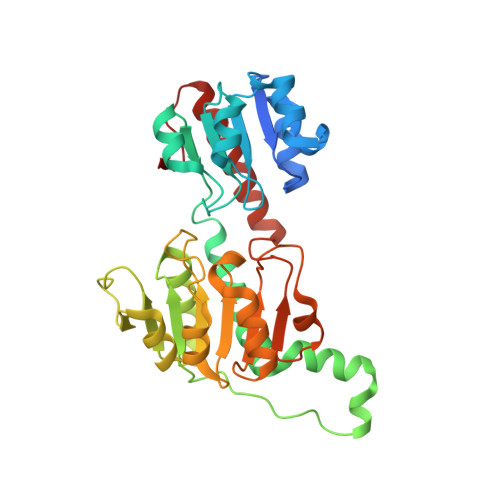An aldo-keto reductase with 2-keto-l-gulonate reductase activity functions in l-tartaric acid biosynthesis from vitamin C inVitis vinifera.
Jia, Y., Burbidge, C.A., Sweetman, C., Schutz, E., Soole, K., Jenkins, C., Hancock, R.D., Bruning, J.B., Ford, C.M.(2019) J Biol Chem 294: 15932-15946
- PubMed: 31488549
- DOI: https://doi.org/10.1074/jbc.RA119.010196
- Primary Citation of Related Structures:
6PEX - PubMed Abstract:
Tartaric acid has high economic value as an antioxidant and flavorant in food and wine industries. l-Tartaric acid biosynthesis in wine grape ( Vitis vinifera ) uses ascorbic acid (vitamin C) as precursor, representing an unusual metabolic fate for ascorbic acid degradation. Reduction of the ascorbate breakdown product 2-keto-l-gulonic acid to l-idonic acid constitutes a critical step in this l-tartaric acid biosynthetic pathway. However, the underlying enzymatic mechanisms remain obscure. Here, we identified a V. vinifera aldo-keto reductase, Vv2KGR, with 2-keto-l-gulonic acid reductase activity. Vv2KGR belongs to the d-isomer-specific 2-hydroxyacid dehydrogenase superfamily and displayed the highest similarity to the hydroxyl pyruvate reductase isoform 2 in Arabidopsis thaliana Enzymatic analyses revealed that Vv2KGR efficiently reduces 2-keto-l-gulonic acid to l-idonic acid and uses NADPH as preferred coenzyme. Moreover, Vv2KGR exhibited broad substrate specificity toward glyoxylate, pyruvate, and hydroxypyruvate, having the highest catalytic efficiency for glyoxylate. We further determined the X-ray crystal structure of Vv2KGR at 1.58 Å resolution. Comparison of the Vv2KGR structure with those of d-isomer-specific 2-hydroxyacid dehydrogenases from animals and microorganisms revealed several unique structural features of this plant hydroxyl pyruvate reductase. Substrate structural analysis indicated that Vv2KGR uses two modes (A and B) to bind different substrates. 2-Keto-l-gulonic acid displayed the lowest predicted free-energy binding to Vv2KGR among all docked substrates. Hence, we propose that Vv2KGR functions in l-tartaric acid biosynthesis. To the best of our knowledge, this is the first report of a d-isomer-specific 2-hydroxyacid dehydrogenase that reduces 2-keto-l-gulonic acid to l-idonic acid in plants.
Organizational Affiliation:
Waite Research Institute, School of Agriculture, Food, and Wine, University of Adelaide, Adelaide 5064, Australia.














